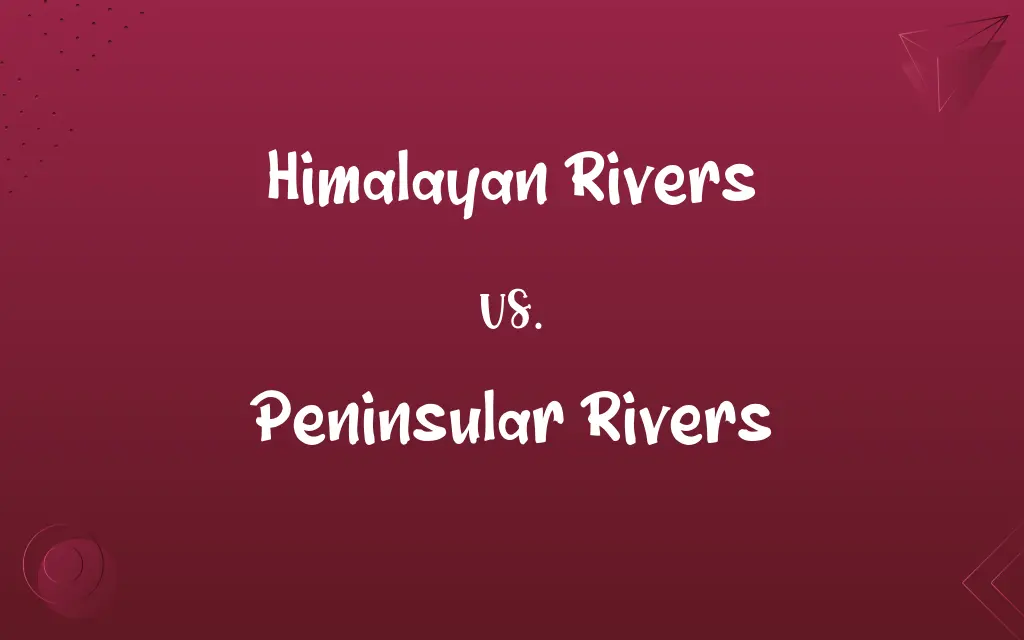Himalayan Rivers vs. Peninsular Rivers: Know the Difference

By Shumaila Saeed || Published on February 13, 2024
Himalayan rivers are perennial, fed by glaciers and monsoons, often flowing through deep valleys, while Peninsular rivers are mostly rain-fed, flowing through relatively shallower valleys.

Key Differences
Himalayan Rivers, originating from the Himalayas, are perennial, receiving water from glaciers and rainfall, thus flowing throughout the year. Peninsular Rivers, originating from the Indian Peninsula, are primarily seasonal, relying mostly on rainfall, and often drying up in the dry season.
Shumaila Saeed
Feb 13, 2024
The Himalayan Rivers, including the Ganges, Brahmaputra, and Indus, traverse long distances and have large catchment areas, leading to extensive river basins. Peninsular Rivers, such as the Godavari, Krishna, and Kaveri, have comparatively smaller basins and shorter courses.
Shumaila Saeed
Feb 13, 2024
Himalayan Rivers are known for their significant role in agriculture due to their extensive alluvial plains, which are highly fertile. In contrast, Peninsular Rivers flow through hard rock regions, resulting in less fertile basins but are crucial for irrigation and hydroelectric power.
Shumaila Saeed
Feb 13, 2024
The flow of Himalayan Rivers is significantly affected by the melting of glaciers and monsoon patterns, whereas Peninsular Rivers depend heavily on the monsoon and have less predictable water flow, leading to variability in their discharge.
Shumaila Saeed
Feb 13, 2024
The Himalayan Rivers have a meandering course due to the flat terrain they flow through after descending from the mountains. Peninsular Rivers, on the other hand, often have a straighter course due to the hard rock terrain of the peninsula.
Shumaila Saeed
Feb 13, 2024
ADVERTISEMENT
Comparison Chart
Source of Origination
Himalayan glaciers and rainfall.
Indian Peninsula's highlands.
Shumaila Saeed
Feb 13, 2024
Nature of Flow
Perennial, flow throughout the year.
Seasonal, dependent on monsoon rains.
Shumaila Saeed
Feb 13, 2024
Catchment Area
Large basins and extensive catchment.
Smaller basins with limited catchment.
Shumaila Saeed
Feb 13, 2024
Role in Agriculture
Fertile alluvial plains, beneficial for agriculture.
Less fertile, but important for irrigation and power.
Shumaila Saeed
Feb 13, 2024
Course and Terrain
Long and meandering through plains.
Comparatively straight, through hard rock terrains.
Shumaila Saeed
Feb 13, 2024
ADVERTISEMENT
Himalayan Rivers and Peninsular Rivers Definitions
Himalayan Rivers
Rivers forming large river basins and alluvial plains in the Indian subcontinent.
Himalayan Rivers like the Ganges create fertile plains suitable for intensive agriculture.
Shumaila Saeed
Jan 23, 2024
Peninsular Rivers
Rivers with comparatively smaller basins and shorter courses.
The Narmada, a Peninsular River, has a shorter course compared to the Himalayan Rivers.
Shumaila Saeed
Jan 23, 2024
Himalayan Rivers
Rivers with significant cultural and religious importance in South Asia.
The Ganges, one of the major Himalayan Rivers, holds immense religious significance in India.
Shumaila Saeed
Jan 23, 2024
Peninsular Rivers
Rivers flowing through hard rock terrains with limited catchment areas.
The Cauvery, a Peninsular River, flows through a region of hard granite terrain.
Shumaila Saeed
Jan 23, 2024
Himalayan Rivers
Rivers originating from the Himalayan mountain range.
The Ganges, a Himalayan River, is vital to the agricultural landscape of northern India.
Shumaila Saeed
Jan 23, 2024
ADVERTISEMENT
Peninsular Rivers
Rivers crucial for irrigation and hydroelectric power in the peninsula.
Tungabhadra Dam, built on a Peninsular River, is pivotal for irrigation and power generation.
Shumaila Saeed
Jan 23, 2024
Himalayan Rivers
Rivers with extensive catchment areas covering several countries.
The Brahmaputra, a trans-boundary Himalayan River, sustains diverse ecosystems along its course.
Shumaila Saeed
Jan 23, 2024
Peninsular Rivers
Rivers that originate from the Indian Peninsula.
The Godavari, a Peninsular River, is often referred to as the Dakshina Ganga or 'Ganges of the South'.
Shumaila Saeed
Jan 23, 2024
Himalayan Rivers
Perennial rivers fed by Himalayan glaciers and monsoon rains.
The Indus River, originating in the Himalayas, flows consistently throughout the year.
Shumaila Saeed
Jan 23, 2024
Peninsular Rivers
Seasonal rivers primarily dependent on monsoon rains.
Peninsular Rivers like the Krishna swell during the monsoon season.
Shumaila Saeed
Jan 23, 2024
Repeatedly Asked Queries
What defines Himalayan Rivers?
Rivers originating from the Himalayas, perennial in nature.
Shumaila Saeed
Feb 13, 2024
Can Himalayan Rivers support large-scale agriculture?
Yes, their extensive alluvial plains are highly fertile.
Shumaila Saeed
Feb 13, 2024
Why are Himalayan Rivers perennial?
They are fed by both monsoon rains and glacial meltwater.
Shumaila Saeed
Feb 13, 2024
What makes Peninsular Rivers seasonal?
Their flow largely depends on the monsoon rains.
Shumaila Saeed
Feb 13, 2024
Are Peninsular Rivers less fertile for agriculture?
Yes, they flow through hard rock regions, resulting in less fertile basins.
Shumaila Saeed
Feb 13, 2024
What is a notable feature of the Krishna River?
It's a significant Peninsular River, essential for irrigation in its basin.
Shumaila Saeed
Feb 13, 2024
Do Himalayan Rivers flow through multiple countries?
Yes, rivers like the Indus and Brahmaputra flow across several countries.
Shumaila Saeed
Feb 13, 2024
Do Peninsular Rivers face environmental challenges?
Yes, challenges include pollution, seasonal variability, and overuse.
Shumaila Saeed
Feb 13, 2024
What is the role of Himalayan Rivers in culture and religion?
They hold immense religious significance, particularly in Hinduism.
Shumaila Saeed
Feb 13, 2024
What are Peninsular Rivers?
Rivers originating from the Indian Peninsula, mostly seasonal.
Shumaila Saeed
Feb 13, 2024
How do Peninsular Rivers affect power generation?
They are key for hydroelectric power due to their steep gradients.
Shumaila Saeed
Feb 13, 2024
What are the environmental concerns with Himalayan Rivers?
Issues like pollution, overuse, and climate change affecting glacial sources.
Shumaila Saeed
Feb 13, 2024
Is navigation possible on Himalayan Rivers?
Yes, in certain parts, especially in the plains.
Shumaila Saeed
Feb 13, 2024
What is the significance of the Ganges River?
It's a major Himalayan River, crucial for agriculture and of cultural importance.
Shumaila Saeed
Feb 13, 2024
Are Peninsular Rivers important for regional ecosystems?
Yes, they support diverse ecosystems along their courses.
Shumaila Saeed
Feb 13, 2024
What economic benefits do Peninsular Rivers offer?
They are crucial for irrigation, drinking water, and hydroelectric power in the peninsula.
Shumaila Saeed
Feb 13, 2024
How do Himalayan Rivers contribute to the economy?
Through agriculture, hydroelectric power, and religious tourism.
Shumaila Saeed
Feb 13, 2024
Can Peninsular Rivers be navigated?
Navigation is limited due to their shorter lengths and seasonal nature.
Shumaila Saeed
Feb 13, 2024
How does climate change impact Himalayan Rivers?
It affects their glacial sources, altering flow patterns.
Shumaila Saeed
Feb 13, 2024
What irrigation practices are associated with Peninsular Rivers?
They often involve building dams and canals for irrigation.
Shumaila Saeed
Feb 13, 2024
Share this page
Link for your blog / website
HTML
Link to share via messenger
About Author
Written by
Shumaila SaeedShumaila Saeed, an expert content creator with 6 years of experience, specializes in distilling complex topics into easily digestible comparisons, shining a light on the nuances that both inform and educate readers with clarity and accuracy.




































































